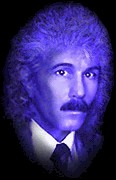 AAPG Site Search |
Home > EXPLORER > Archives
> April 2001 >
Senteur de who?
AAPG Site Search |
Home > EXPLORER > Archives
> April 2001 >
Senteur de who?
| Published April 2001 in the AAPG Explorer
|  |
de Boue (Great Geologist?) Gets Last LaughThis Web Site Has An Attitude |
By DAVID BROWN
|
Ten reasons to visit www.sjgs.com, the Web site of the San Joaquin Geological Society (SJGS) in Bakersfield, Calif.:10. To see Dan the Otter. 9. It's one of the few geological Web sites to carry a lewd photograph of a cactus. (Really) 8. For meeting information, click the dancing penguins. 7. Short refresher course on "How to Find Oil and Gas." 6. Find the flying pig. 5. Scope out SJGS publications. 4. Clinton jokes. Lots of 'em. 3. A history of oil in Kern County, Calif. 2. Bad puns. Very bad puns. And the Number One reason to visit the society's Web site: 1. It includes a shrine to that most elusive of geological geniuses, the "possibly fictional" Jean B. Senteur de Boue. Beyond that, the SJGS Web pages provide an interesting study for other groups hoping to establish a presence on the Internet. It gives information. Lots of it. But it also has a certain Mad Magazine-esque personality that defies the stereotypical self-important, multiple-pins-on-the-lapel approach to communicating. In short, it's hip, irreverent and it makes it apparent that petroleum geologists actually have a sense of humor. The site maybe should include
The creative mind behind the site belongs to Web master Mike Clark, staff geologist for Chevron in Bakersfield. Clark said the idea for a Web page started four years ago with the society's executive committee. "We sat down and came up with a page initially to notify members of when the meetings were. As it developed, other people had suggestions and those were included," he explained. Today, the Web page has become "part of the lifeblood" of SJGS, according to Clark. "If I said I was tired of this and want out, there would be a committee come together very quickly to keep it going," he said. Creative InterpretationsBut what of Senteur de Boue? Like many geologists, Senteur de Boue had rocks in his head from an early age. He allegedly attended the University of Lyons, near Lyons, France, and later moved to the United States. According to the SJGS site, "Monsieur de Boue's name in French loosely translates to 'Mud Sniffer'." Clark called Senteur de Boue a "legendary member" of the San Joaquin society. His name supposedly appears in the 1955 directory of the Pacific Section of AAPG, listing him as an independent consultant with an office on Oak Street in Bakersfield. As SJGS records show, "this address corresponds to a Tidewater service station that was once located across from the Oceanic (Oil Company) offices." Senteur de Boue's name may be most closely linked to his pioneering work in Negative Isopach Theory. The SJGS Web site carries a precis of this important contribution. The author explains that "many maps containing negative isopachs are computer-generated and result from sophisticated software packages incapable of producing erroneous data. "Nonetheless, because negative isopachs require the rocks in question to have negative thickness and volumes, some geologists of the old school reject this possibility." By closely studying negative isopachs, Senteur de Boue traced their origin to two processes: bi-directional erosion and ultra-high rates of erosion. He observed that such isopachs "are economically appealing because of rock properties that include porosities and net-to-gross sandstone ratios greater than 1.0. "For example, if a reservoir rock is saturated with oil, and total pore volume within the reservoir exceeds the volume of rock matrix, then the volume of oil exceeds the negative volume represented by the negative isopach. Thus, infinite production is possible." These concepts also apply to calcerous, calciclastic and recalcitrant formations. In an alleged poster presentation at a 1997 meeting of the San Joaquin society, Senteur de Boue offered a new and disturbing interpretation of the likely origins of California's Ventura Basin. Rejecting earlier theories of tectonic rotation, he suggested that the entire basin resulted from a meteor impact. The SJGS site presents his novel ideas about giant clinoforms in the area. Even more disturbing is recent "evidence" uncovered by Hanswurst, Zopenco, et. al., indicating that the San Joaquin Valley itself may be an elaborate hoax. "If the valley is, in fact, spurious," Zopenco noted, "somebody went to an amazing amount of trouble." Hanswurst, Zopenco et. al could not be contacted by the EXPLORER for comment. Starting the Web SiteClark said SJGS started out with a Geocities Web site but wanted its own, copyrighted site name. The society found a Web hosting service associated with the local newspaper, and now pays $100 annually for its proprietary site. "You can contact local organizations to see if there's one willing to sponsor a site," he said. "However, if you want to have your own site name, you'll need to go ahead and make the payments." Clark considers the hosting fee a bargain. "What we get for $100 a year, other outfits are paying $50-$60 a month for," he said. The society's Web site serves as a centralized information point, according to Frank Cressy, a consulting geologist in Bakersfield and former secretary of AAPG's Pacific Section. "There's just a lot of information you can get from it," he said. "I use it a lot for the links. There must be 30-40 links on there." An organization wanting to start a Web site should get its own site address and find a local hosting service, Clark advised. He said the designated Web master should solicit the membership for help, ideas and quality control. "I'm very dependent on people spotting things that are wrong," he said. "I can't go through it and QC everything." Time to LaughIn addition to details about Senteur de Boue (no relation to Ame de Boue of the Bush Administration), the SJGS site carries a humor page with several entries dedicated to the antics of Bill Clinton. This may be a crisis of sorts for the site, since Clinton has given up his role as Washington's premier goret. "I'll have to get around to doing something about that," Clark acknowledged. Clark estimated that he spends an hour updating the Web site every other week. "During the past couple of years it's been more of a maintenance activity," he said. He also runs a site for a local Boy Scouts of America troop. A committee can help a site get started and succeed, but there should be only one Web master, Clark warned. "You can't have multiple Web masters," he said. "Then you're both uploading and you don't know what each other's doing." Clark mastered enough Web coding to build the SJGS site himself, although many, easy-to-use Web design products are available, he noted. "I write it from scratch," he said. "It's very simplistic, once you learn the basics on the code. It's not very intimidating at all." If he sees something he likes elsewhere on the Web, he examines the code and can add it to the SJGS site. Other ideas are suggested by society members. "People say, 'It would be neat if we had this,' and if I get a free block of time, I go and round it up," he said. The SJGS Web site includes links to other societies, basic information about oil and gas, and a number of links to sites of interest to petroleum geologists. "Click spot," the home page directs, "cause he knows where to go." It also provides information about the AAPG's Division of Professional Affairs Certified Geologist program as well as an oil industry exhibit at the Kern County Museum. In addition to jokes about the foibles of human beings, the site includes humor related to engineers and lawyers. It takes care to follow the commandment, "Thou shalt not be boring." Clark knows SJGS members value their Web site, and watch it closely: "If it goes down, or if it isn't available for awhile, I'll hear about it pretty quickly."
|
|

 We're
not sure about the identification for what's shown here, but you
can find the uncensored image with just a few well placed clicks.
We're
not sure about the identification for what's shown here, but you
can find the uncensored image with just a few well placed clicks.